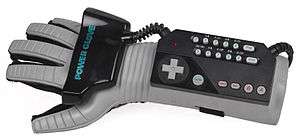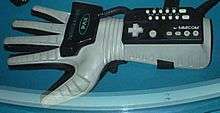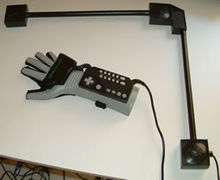Power Glove
 Power Glove, American model | |
| Manufacturer |
Mattel (United States) PAX (Japan) |
|---|---|
| Type | Video game controller |
| Generation | Third generation era |
| Release date |
|
| Retail availability | 1 year |
| Introductory price | US$75 (equivalent to $148.07 in 2017) |
| Discontinued | 1990 |
| Connectivity | Serial port |
The Power Glove is a controller accessory for the Nintendo Entertainment System. The Power Glove gained public attention due to its early virtual reality mechanics and being shown in various forms of media. However, its two games did not sell well, as it was not packaged with a game, and it was criticized for its imprecise and difficult-to-use controls.[2]
Development

The Power Glove was originally released in 1989.[3] Though it was an officially licensed product, Nintendo was not involved in the design or release of this accessory. Rather, it was designed by Grant Goddard and Samuel Cooper Davis for Abrams/Gentile Entertainment (AGE), made by Mattel in the United States[3] and PAX in Japan. Additional development was accomplished through the efforts of Thomas G. Zimmerman and Jaron Lanier, a virtual reality pioneer responsible for codeveloping and commercializing the DataGlove,[4] who had made a failed attempt at a similar design for Nintendo earlier. Mattel brought in Image Design and Marketing's Hal Berger and Gary Yamron to develop the raw technology into a functional product. They designed Power Glove over the course of eight weeks.[5][6][7] The Power Glove and DataGlove were based on Zimmerman's instrumented glove.[8] Zimmerman built the first prototype that demonstrated finger flex measurement and hand position tracking using a pair of ultrasonic transmitters. His original prototype used optical flex sensors to measure finger bending which were replaced with less expensive carbon-based flex sensors by the AGE team.
Design and functionality

The glove has traditional NES controller buttons on the forearm as well as a program button and buttons labeled 0-9. The user presses the program button and a numbered button to input commands, such as changing the firing rate of the A and B buttons. Along with the controller, the player can perform various hand motions to control a character on-screen.
The Power Glove is based on the patented technology of the VPL Dataglove, but with many modifications that allow it to be used with modestly performing consumer hardware and sold at an affordable price. Whereas the Dataglove can detect yaw, pitch and roll, uses fiberoptic sensors to detect finger flexure, and has a resolution of 256 positions (8 bits) per finger for four fingers (the little finger is not measured to save money, and it usually follows the movement of the ring finger), the Power Glove can only detect roll, and uses sensors coated with conductive ink yielding a resolution of four positions (2 bits) per finger for four fingers.[9] This allows the Power Glove to store all the finger flexure information in a single byte.[10] However, it appears that the fingers actually feed an analog signal to the microprocessor on the Power Glove. The microprocessor converts the analog signal into two bits per finger.
There are two ultrasonic speakers (transmitters) in the glove and three ultrasonic microphones (receivers) around the TV monitor. The ultrasonic speakers take turns transmitting a short burst (a few pulses) of 40 kHz sound and the system measures the time it takes for the sound to reach the microphones. A triangulation calculation is performed to determine the X, Y, Z location of each of the two speakers, which specifies the yaw and roll of the hand. The only dimension it cannot calculate is the pitch of the hand, since the hand can pitch without moving the location of the two ultrasonic speakers.
Games
Two games were released with specific features for use with the Power Glove: Super Glove Ball, a faux-3D puzzle maze game; and Bad Street Brawler, a beat 'em up. Both games are playable with the standard NES controller, but include moves that can only be used with the glove. These two games are branded as part of the "Power Glove Gaming Series". Since no Power Glove-specific games ever retailed in Japan, the Power Glove was sold only as an alternative controller.
Two more games, Glove Pilot and Manipulator Glove Adventure, were announced but never released. Another unreleased game, Tech Town or Tektown, is a virtual puzzle solving game in which the player moved a robotic hand around a deserted space station type of setting, using the glove to open doors and to pick up and use tools. It can be seen in a sneak peek in the Official Power Glove Game Players Gametape.[11]
Games without specific support can also be played with the glove by inputting codes on the glove's keypad that set a control scheme for the glove.
Reception
The Power Glove sold nearly one million units.[12]
In popular culture
The Power Glove is prominently shown in the Nintendo-produced film The Wizard, wielded by antagonist Lucas Barton (Jackey Vinson), whose smug boast, "I love the Power Glove. It's so bad," became an Internet meme years later.[13][14]
In Freddy's Dead: The Final Nightmare (1991), after losing his controller that was controlling Spencer, Freddy gets controls on his clawed glove while saying “Hey, you forgot the Power Glove!”[15]
In 2013, a documentary about the Power Glove, called The Power of Glove, was put into development.[16][17]
American instrumental power metal/Nintendocore cover band Powerglove took their name from the accessory.
In the American animated series Regular Show, season 3, episode 19, "Video Game Wizard", the characters enter a competition hoping to win the "maximum glove," a parody of the Nintendo Power Glove. It even includes the saying, "I love the maximum glove. It's so bad."
References
- ↑ Vizard, Frank (October 1989). "Popular Mechanics". Vol. 166 no. 10. p. 106. ISSN 0032-4558. Retrieved March 15, 2018.
...Power Glove comes in two sizes, and is targeted at players between the ages of 8 and 14...
- ↑ "Backwards Compatible - The Power Glove". ABC website - Good Game. Australian Broadcasting Corporation (ABC). 19 May 2008. Retrieved 2009-06-06.
- 1 2 "A.G.E. Tech". Abrams Gentile Entertainment. Archived from the original on 25 May 2015. Retrieved 13 May 2009.
- ↑ "History". Scott Belsley, MD, FACS. Archived from the original on 30 December 2008. Retrieved 16 December 2015.
- ↑ Applegate, Jane (21 June 1991). "Putting a Design on Bigger Market Share". Los Angeles Times. Retrieved 2014-09-28.
- ↑ "Inside story on: The power glove (Cover)" (PDF). Design News. 45 (23): 63. 4 December 1989. Retrieved 16 December 2015.
- ↑ "La Réalité Virtuelle - Chapitre 7".
- ↑ "Patent US4542291 - Optical flex sensor".
- ↑ Townsend, J. Eric. "PowerGlove FAQ". Mellott's VR. Retrieved 17 December 2015.
- ↑ "1993 VR Conference Proceedings". North Carolina State University. 1993. Archived from the original on 7 July 2009. Retrieved 13 May 2009.
- ↑ New Game Available. Official Power Glove Game Players Gametape (VHS). 1. Spring 1991.
- ↑ Zachary, George (November 1996). "Generator". Next Generation. No. 23. Imagine Media. p. 24.
- ↑ "X-Entertainment: THE WIZARD Movie Review!".
- ↑ "I-Mockery.com - Nintendo - The Good, The Bad, and The Ugly".
- ↑ https://www.youtube.com/watch?v=otBNYc0lJ6Y
- ↑ Matulef, Jeffrey (13 July 2013). "The Power Glove gets its own feature-length documentary". Eurogamer. Gamer Network. Retrieved 6 August 2014.
- ↑ "There's a Nintendo Power Glove Documentary Coming (Yes, It Has a Wizard Reference)". WIRED. 11 July 2013.
| Wikimedia Commons has media related to Power Glove. |
